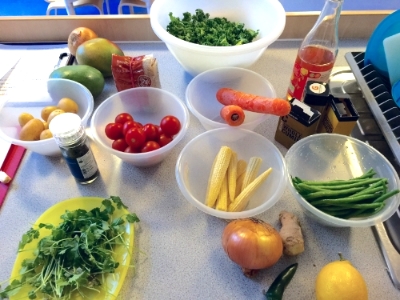For the third week of our six-week Healthy Eating Fast Food/Takeaway Alternatives course we made a vegetarian curry and a mango chutney. Each week we always have a vegetarian option but this week we opted to go all vegetarian. A combination of an overly large pan, an electric stove and baby tomatoes left this recipe rather dry and we were glad for our mango chutney that we had made but I have tweaked the recipe a bit or if you prefer a dryer curry you can omit the vegetable stock. I recommend getting the mango chutney made first and put to the side or do all the prep of the ingredients for both the vegetable curry and mango chutney and make then side by side. The vegetable curry can easily have meat, seafood or tofu added to it
ingredients for vegetarian curry
Indian remains one of the most popular takeaway meals in the UK and in London we are spoilt with amazing Indian takeaway and restaurant options at all price points. Whilst working on Brick Lane I could not muster up the self control to not walk the twenty paces from where I worked to Ambala where I would eat three samosas a day as a late afternoon snack. I never even considered how many calories or grams of fat were in each samosa and when I researched this I was really surprised to see that I had been adding almost 500 extra calories and 25 grams of fat each day. I'm still unable to be near an Ambala and not get samosas but now I have it as a treat and limit myself to one meat and one veg samosa instead of my minimum three. Here are some more average amount of calories and grams of fat (respectively) in Indian takeaways:
Chicken Biryani - 1000 cal, 43 grams of fat
Chicken Korma - 860 cal, 50 grams of fat
Lamb Rogan Josh - 650 cal, 37 grams of fat
Vegetable Jalfrezi - 460 cal, 30 grams of fat
Garlic naan the whole naan - 760 cal, 25 grams of fat
Onion bhaji - 2 bahjis - 450 cal, 25 grams of fat
Poppadoms - 2 poppadom - 70 cal, 5 grams of fat
Meat or veg samosa - 1 samosa - 145 cal, 8 grams of fat
Indian Takeaway tips:
Many dishes are loaded with oil, ghee and fat and with pilau rice, starters and side dishes, Indian takeouts can quickly end up meeting and going beyond your daily recommended allowances and not is a healthy way at all.
Avoid the creamier based reamy curries like masala and korma which are higher in calories and fat. Tomato based curries like jalfrezi, rogan or madras are a better choice, or opt for dry dishes like biryanis. Some ways to make substitutions and save on calories include choosing plain boiled rather than pilau, chappati rather than naan, choosing veggie curries and opting out or reducing the number of fried starters such as samosas and bhajis.
Vegetable Curry Recipe
INGREDIENTS
500 g vegetables i.e.-cauliflower, green beans, carrots, aubergine
200 g potatoes, peeled and cut into 1 cm squares
6 tomatoes, chopped finely or a tin of tomatoes
2 onions - thinly sliced into crescents
300 ml vegetable stock
4 tbsp coconut oil, canola oil or alternative oil
2 cloves garlic - finely chopped or minced
1 tbsp fresh ginger root, peeled - finely chopped or minced
1 tsp cumin seeds - if you do not have cumin seeds you can use ground cumin
1 tsp ground coriander
1/4 tsp garam masala
1/4 tsp turmeric
1/4 tsp paprika
2 pinches of sea salt
1/4 tsp freshly ground pepper - or more if desired personal taste
Fresh coriander - washed handful, roughly chopped
Fresh lemon juice from half a lemon - strained to remove seeds
INSTRUCTIONS
- Prepare the vegetable stock by either warming homemade vegetable stock or use a high quality powdered stock that is free from additives or MSG.
- Toast the cumin seeds in a pan under medium heat while constantly stirring with a wooden spoon for 3 minutes making sure that the seeds do not burn. Grind the toasted cumin seeds and add all the readily ground spices into a small bowl ready to add later on in the recipe.
- Warm the oil in a large pan at medium heat and add the onions and cook slowly until transparent. Do not let them brown or dry out, add a spoonful of the vegetable stock should the onions start to dry out or brown.
- Add the ginger and garlic and cook for one minute, stirring all the while. Reduce the heat or add a spoonful of the stock should the garlic and ginger and start to brown, do let them burn.
- With the pan at medium heat, stir the ground spices into the onions, garlic and ginger and keep stirring until they are thoroughly mixed in, about three minutes.
- Now add the tomatoes and stock and keep stirring until everything is mixed together well, about 5 minutes.
- Add the vegetables and stir to mix throughout, cover and cook on low to mediumheat for 30 minutes or until vegetables potatoes are thoroughly cooked to desired texture. Stir in fresh lemon juice and fresh coriander, stir and serve with brown rice.
Quick Mango Chutney Recipe
INGREDIENTS
1 mango chopped into small irregular pieces
1/4 onion finely chopped or minced
1/2 - 1 chili - depending on personal taste - de-seeded and finely chopped
150 ml cider vinegar
100g sugar
1/2 tsp cumin
1/2 tsp coriander
pinch of salt
INSTRUCTIONS
- Combine the sugar and cider vinegar in a pan over medium heat until the sugar is dissolved.
- Add the mango pieces to the mixture and stir.
- Add the spices and salt and increase heat stirring all the while.
- Once the mixture has been boiling for 3-5 minutes, reduce the heat to low, stir occasionally to avoid burning and allow the chutney to thicken which should take 15 -30 minutes.
- Once the chutney is at the desired thickness remove it from the stove and place in a glass container.
- This is a quick chutney recipe that is meant to be served while fresh alongside a curry and eaten right away or kept for a few days wrapped up and kept in a fridge.


